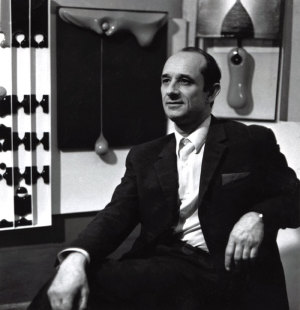 Urodził się w Łodzi w 1923 gdzie zmarł w 1997. Malarz, rzeźbiarz, grafik, architekt, studiował w PWSSP w Łodzi u Władysława Strzemińskiego. W 1947 roku publikuje wspólnie ze Strzemińskim artykuł Widzenie gotyku. W latach czterdziestych należy do Klubu Młodych Artystów i Naukowców w Warszawie. W ramach tego klubu bierze udział w wystawach w Salonie Poprostu, Zachęcie, Klubie Literatów.
Urodził się w Łodzi w 1923 gdzie zmarł w 1997. Malarz, rzeźbiarz, grafik, architekt, studiował w PWSSP w Łodzi u Władysława Strzemińskiego. W 1947 roku publikuje wspólnie ze Strzemińskim artykuł Widzenie gotyku. W latach czterdziestych należy do Klubu Młodych Artystów i Naukowców w Warszawie. W ramach tego klubu bierze udział w wystawach w Salonie Poprostu, Zachęcie, Klubie Literatów.
W czasie studiów organizuje klub pod patronatem YMCA w Łodzi, a od 1953 roku za namową Konrada Swinarskiego współdziała z grupą St-53 w Katowicach.
W latach 1957-1997 roku prowadzi zajęcia z grafiki projektowej, warsztatowej i kompozycji plastycznej w łódzkiej PWSSP (obecnie Akademia Sztuk Pięknych im. Władysława Strzemińskiego). Wykłada też historię sztuki i analizę formy plastycznej. W 1963 roku uzyskuje dyplom architekta na Wydziale Architektury Politechniki Warszawskiej. Projektuje i realizuje wiele tematów z zakresu architektury, planowania przestrzennego. Równocześnie uprawia malarstwo, grafikę, rzeźbę, pisze i publikuje teksty o sztuce. Uczestniczy w plenerach w Osiekach i sympozjach Złotego Grona.
Od 1975 roku kontynuując pracę w PWSSP tworzy pracownię rzeźby i kompozycji w Instytucie Architektury i Urbanistyki Politechniki Łódzkiej. Obrazy z okresu studiów nawiązują do kubizmu i solaryzmu Strzemińskiego. Obrazy z lat 50-tych inspirowane są sztuką Egiptu i Grecji. Powstają też prace taszystowskie. Lata 60-te, to malarstwo materii, rzeźba w drewnie i grafika. Pojawiają się obrazy i gwasze inspirowane cmentarzem żydowskim w Pradze. W następnych latach tworzył płaskorzeźby i reliefy polichromo-wane, oraz obiekty konceptualne (Ośrodek Kondensacji Formy I, II i III). Z tego okresu pochodzą też fotomontaże nawiązujące do OKF II. Pod koniec lat 70-tych w swych ascetycznych obrazach olejnych nawiązuje do konstruktywizmu. Pojawia się w nich problem analizy kwadratu, jego przetworzenia do formy znaku. Ten okres twórczości zapewnia artyście trwałe miejsce w historii sztuki polskiej. Obok obrazów czysto geometrycznych w formie artysta maluje obrazy nawiązujące do ikonografii i kultury euro-pejskiej. Ostatni okres aktywności twórczej artysty wypełniło malarstwo symultaniczne. Prace Stefana Krygiera znajdują się m.in w Muzeum Narodowym w Warszawie, Muzeum Narodowym w Szczecinie, Muzeum Sztuki w Łodzi, w muzeach miejskich i regionalnych w Polsce oraz w licznych kolekcjach prywatnych w Polsce i w Europie.
STEFAN KRYGIER (b. 1923 in Łódź – d. 1997 in Łódź) studied at State Academy of Fine Arts (now Władyslaw Strzemiński Akademy of Fine Arts) in Łódź between 1946 and 1951, and at the Department of Architecture of the Warsaw Polytechnic between 1959 and 1963. Painter, graphic artist, sculptor, architect, professor of the Academy of Fine Arts in Łódź and of the Łódź Politechnic, at the Department of Architecture and Urban Planning.
He was a student, a collaborator (on exhibitions projects), and in time, also a friend, of the outstanding Polish artist, Władysław Strzemiński.
Like Strzemiński, Krygier saw his work as resulting from intellectual reflection and formal experimentation. After his graduation from the Academy, in the 1950s and early 1960s he created oil paintings, distempers, and gouaches inspired by the ancient Egyptian and Greek art. After the figurative period, he set out, in 1963-4, to create a series of paintings-reliefs, graphic works and bas reliefs, whose main focus was structural exploration.
At that time he built the structure of his compositions out of recurring geometrical forms – especially the arc. During the late 1960s and the 1970s he was actively participating in the formation of the Polisch art scene, taking part in many meetings, plain-air workshops, and symposiums of artists, scholars, and art theorists, and in the art events prepared by Polish Conceptualists. During that period he created the series of reliefs and spatial forms made of polychrome wood, entitled Collineations, Conflicts, The Centre of Conden-sation I and II, and geometrical paintings in oil. In early 1980s, Krygier began a new series of paintings entitled The Simultaneity of Form, continuing work on this project until the end of his active life. The series represented his return to figurative painting. It was only in 1996 that he turned again to geometrical forms (within the same series). As an architect, he designed several of Łódź housing estates, many public buildings and urban planning arrangements. His extensive and original oeuvre has secured a place for him in the history of Polish modern art. As a pedagogue of the Łódź Academy of Fine Arts he embodied the best of its traditions, and promoted Włady-sław Strzemiński’s ideas and methods of teaching, which can be regarded as modern even today. He exhibited his works in many museums and galleries in Poland, and also England, Denmark, Germany, Switzerland and Belgium. His works are in the collections of National Museum of Warsaw, National Museum of Szczecin, The Art Museum (Muzeum Sztuki) in Łódź, in several regional and city museums in Poland and in private collections in Poland and Europe.